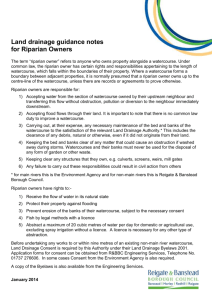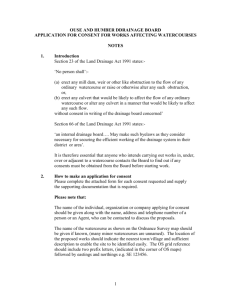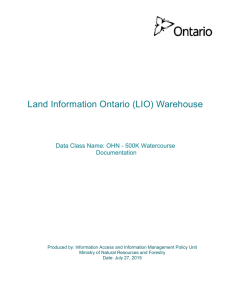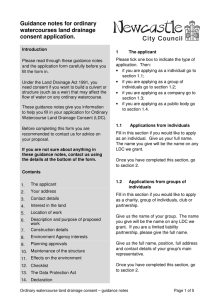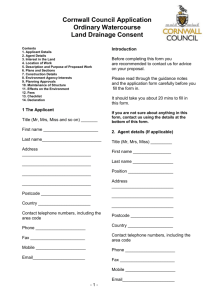Applicant name and address Section 3 – Description of the proposal
advertisement
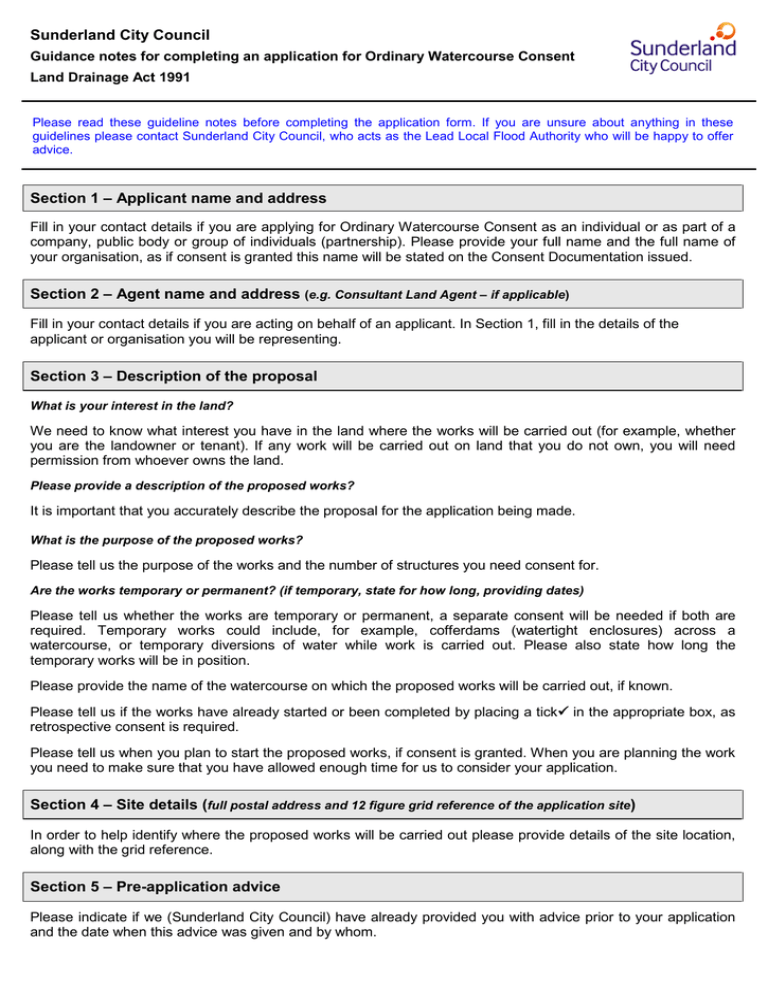
Sunderland City Council Guidance notes for completing an application for Ordinary Watercourse Consent Land Drainage Act 1991 Please read these guideline notes before completing the application form. If you are unsure about anything in these guidelines please contact Sunderland City Council, who acts as the Lead Local Flood Authority who will be happy to offer advice. Section 1 – Applicant name and address Fill in your contact details if you are applying for Ordinary Watercourse Consent as an individual or as part of a company, public body or group of individuals (partnership). Please provide your full name and the full name of your organisation, as if consent is granted this name will be stated on the Consent Documentation issued. Section 2 – Agent name and address (e.g. Consultant Land Agent – if applicable) Fill in your contact details if you are acting on behalf of an applicant. In Section 1, fill in the details of the applicant or organisation you will be representing. Section 3 – Description of the proposal What is your interest in the land? We need to know what interest you have in the land where the works will be carried out (for example, whether you are the landowner or tenant). If any work will be carried out on land that you do not own, you will need permission from whoever owns the land. Please provide a description of the proposed works? It is important that you accurately describe the proposal for the application being made. What is the purpose of the proposed works? Please tell us the purpose of the works and the number of structures you need consent for. Are the works temporary or permanent? (if temporary, state for how long, providing dates) Please tell us whether the works are temporary or permanent, a separate consent will be needed if both are required. Temporary works could include, for example, cofferdams (watertight enclosures) across a watercourse, or temporary diversions of water while work is carried out. Please also state how long the temporary works will be in position. Please provide the name of the watercourse on which the proposed works will be carried out, if known. Please tell us if the works have already started or been completed by placing a tick in the appropriate box, as retrospective consent is required. Please tell us when you plan to start the proposed works, if consent is granted. When you are planning the work you need to make sure that you have allowed enough time for us to consider your application. Section 4 – Site details (full postal address and 12 figure grid reference of the application site) In order to help identify where the proposed works will be carried out please provide details of the site location, along with the grid reference. Section 5 – Pre-application advice Please indicate if we (Sunderland City Council) have already provided you with advice prior to your application and the date when this advice was given and by whom. Sunderland City Council Guidance notes for completing an application for Ordinary Watercourse Consent Land Drainage Act 1991 Section 6 – Environment Agency interests Please tick the appropriate boxes. If you answer ‘yes’ to any of the questions stated, you will probably need extra licenses or consents from the Environment Agency before you start work. You need to ensure that you have enough time to get all the approvals you need before you start work. If you do not, this could delay the work. Contact us or the Environment Agency if you have any questions on how you should proceed. Section 7 – Maintenance We need to know who (individual/organisation) will be responsible for maintenance both during construction work and after the work has been completed. Section 8 – Planning Please inform us by placing a tick, whether the works form part of larger works or development which requires planning permission. Please provide the reference number of the planning application if known. Section 9 – Environmental effects We have a legal duty to protect and improve the environment so we must consider the environmental effects of your proposal. You may need to carry out an Environmental Appraisal or Water Framework Directive Assessment to assess the impacts of the proposed works. You should contact us before submitting this consent form so we can provide advice on additional documentation needed in support of your application. The Water Framework Directive Assessment will assess the impacts of the proposed works on the watercourse, in relation to its ecological and chemical status/potential. No deterioration to the current status of the water body is permitted and improvements may be able to be delivered in tandem with your works. For example delivery of wider statutory requirements, such as the objectives of River Basin Management Plans. The Environmental Appraisal will identify all likely significant effects of the proposed works on the environment. You should consider the direct and indirect effects the work has on sites and features of interest and species of particular value. Include in this section any specific measures you plan to keep disruption to a minimum and reduce any unwanted effects while the work is being carried out. Set out opportunities for you to improve the environmental value of the site. This may include creating water features, planting trees and shrubs that would normally grow at the site, providing bird nesting boxes or creating sustainable places for wildlife to live. If as part of a planning application an Environmental Appraisal was requested, you should attach a copy to your application submission. If your site falls within, is next to or is linked to a nature conservation site, again contact us as soon as possible to discuss the proposed works before you send us your application. Under National and European Regulations, we must make sure that the granting of Ordinary Watercourse Consent does not have a direct or indirect negative effect on any specified sites, including: • Sites of Special Scientific Interest (SSSI’s) • Special Areas of Conservation (SAC’s) • Special Protection Areas (SPA’s) • Ramsar sites • Scheduled Ancient Monuments (SAM’s). Under the European Habitats Regulations, we must consult Natural England. You may want to contact this organisation yourself to get their views on your proposal. Sunderland City Council Guidance notes for completing an application for Ordinary Watercourse Consent Land Drainage Act 1991 Section 10 – Council employee / member Please inform us if you are, or are related to a member of staff or elected member by placing a tick in the appropriate box. Also state the nature of your relationship along with names and job roles. Section 11 – Attachments / checklist In order to validate your proposal the following need to be posted along with your application. i. The application fee of £50, by cheque payable to ‘Sunderland City Council’. ii. To consider your proposals we need to receive plans and drawings, drawn by a competent engineer or surveyor and showing Ordnance Datum Newlyn (the height above sea level). You need to provide three copies of all relevant drawings. The drawings must be no larger than A0 size, and they need to include the following: • A Location Plan - This must be at an appropriate scale and be based on an Ordnance Survey map. It must clearly show the general location of the site where the proposed works will be carried out and include general features and street names. It must also identify the watercourse or other bodies of water in the surrounding area. • A Site Plan (general arrangement) - You must provide a plan of the site showing: - the existing site, including any watercourse(s) - your proposals - the position of any structures which may influence local river hydraulics, including bridges, pipes and ducts, ways of crossing the watercourse, culverts and screens, embankments, walls, outfalls and any other structures - existing fish passes or structures intended to allow fish to pass upstream and downstream. The plan should be drawn to an appropriate scale, which must be clearly stated. • Cross Sections - Where works encroach into a watercourse, you should provide cross sections both upstream and downstream of the proposed works. Cross sections should be drawn as if looking downstream on the watercourse and should include details of existing and proposed features and water levels. • Longitudinal Sections - Longitudinal sections taken along the centre line of the watercourse are needed. These must show the existing and proposed features including water levels, bed levels and structures. They should extend both upstream and downstream of the proposed works. • Detailed drawings - These are to detail existing and proposed features such as the following: - The materials to be used for any structures. - The location of any proposed service pipes or cables which may affect the future maintenance of the watercourse. - Details of any habitats and species that may be affected by the proposed works. - Details of any planting or seeding. - Dams and weirs. We need a plan showing the extent of the water impounded (held back) under normal and flood conditions so that we can assess the possible effect on land next to the river. - The plan must also show any land drains to be affected. Sunderland City Council Guidance notes for completing an application for Ordinary Watercourse Consent Land Drainage Act 1991 Section 11 continued iii. Attach a Water Framework Directive Assessment or Environmental Appraisal if one is required, for example if you have been informed that one is required during pre-application discussions with Sunderland City Council (who hold the responsibility of Lead Local Flood Authority [LLFA]). iv. Please provide a method statement detailing: - how the works will be constructed - when the works will be constructed - how long construction will take - any temporary works - the programme of works - how flood risk will be managed during construction (including any specific measures to do so) - pollution protection arising from the construction of the works - how issues associated with flora and fauna will be managed. When you are planning the work you need to make sure that you have allowed enough time for us to consider your application. The method statement needs to be approved in writing by Sunderland City Council as the LLFA before work can commence. Section 12 – Declaration By signing this section you are declaring that, as far as you know, the information you have provided, including the map and any supporting documents, are true. We will not accept any application that is not signed. Additional notes If there is any other information you have in support of your application or there is a query you wish to raise, please detail this within this section. Send the application form and attachments to: Development Control,PO Box 102,Civic Centre, Sunderland SR2 7DN email:-dc@sunderland.gov.uk
